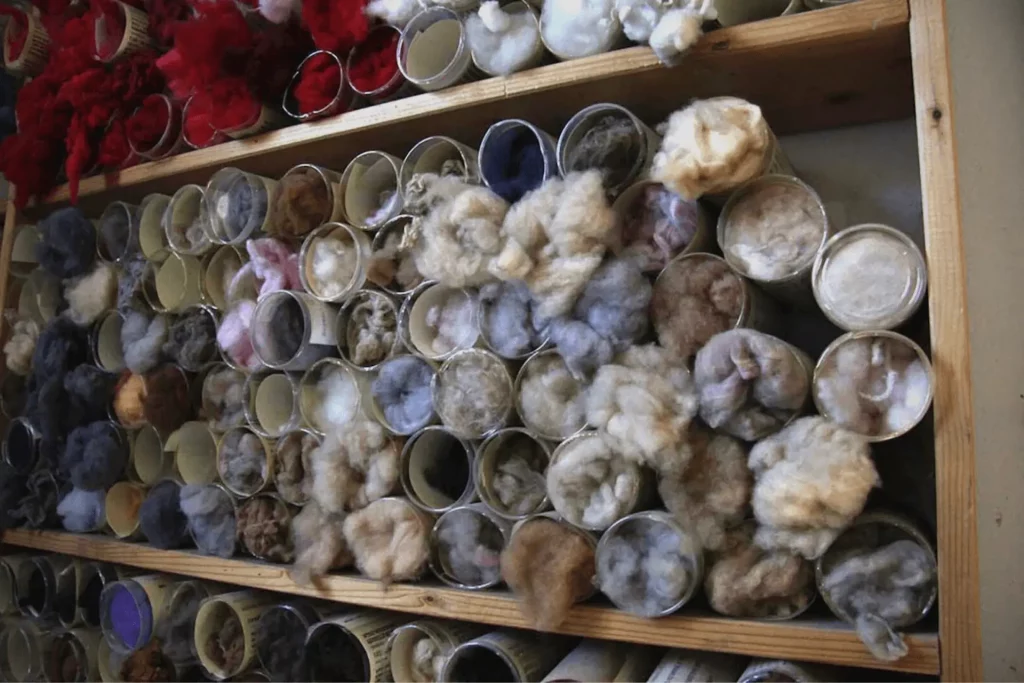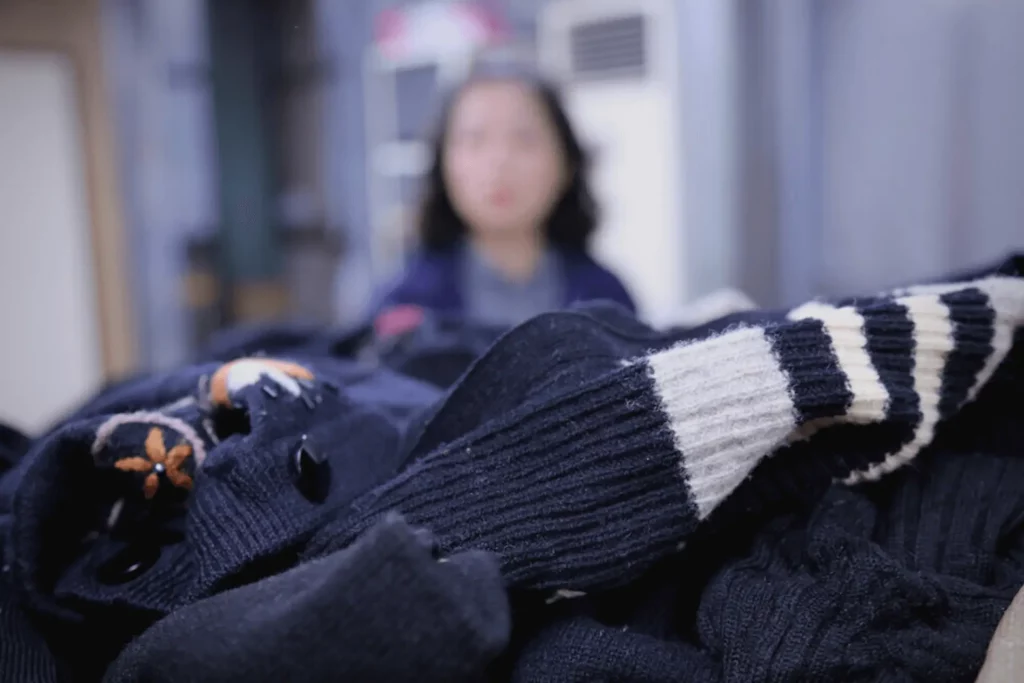The cashmere used in a previous garment or otherwise repurposed is “recycled cashmere.” Cashmere is a deluxe material created from goats’ hair and utilized in the production of high-end apparel. Recycling cashmere not only helps cut down on waste and pollution but also makes for a more environmentally responsible method of clothing production.
The process of recycling cashmere may be accomplished in several different methods. One method is to shred it and then use the shredded material as stuffing for other items or clothing. It is also possible to feel it, which may then be utilized to create new yarns or textiles. And ultimately, it is possible to transform it into various items, such as those for the house or accessories.
There are a lot of positive aspects to using recycled cashmere. Not only does it aid in the reduction of trash, but it also contributes to the production of more environmentally friendly clothing. You may experience the same advantages as virgin cashmere, but without guilt, since it is just as soft and comfortable as pure cashmere.
Suppose you are interested in supporting businesses committed to reducing their environmental impact when shopping for cashmere. In that case, you can search for firms that use recycled inner products.
You might also browse for used cashmere goods, frequently in just as good of condition as brand-new cashmere. If you choose recycled cashmere, you are not only doing your part to assist the environment, but you are also reducing your influence on the earth.
Table of Contents
How is Recycled Cashmere Created, and What Exactly is it?
Recycled cashmere is alternative to virgin cashmere that is both more sustainable and better for the environment. It is created from cashmere clothes used previously and then discarded. These garments are then gathered, shredded, and spun into new yarn.
The procedure for recycling cashmere is, in all honesty, not that complicated. When the cashmere garments have been gathered, they are further shredded into very minute bits. Afterward, the pieces are combed and cleansed to eliminate any remaining contaminants. In the end, the fibers are spun into new yarn, which may then be utilized in producing a wide variety of clothing items.
Recycled cashmere is not only more sustainable than virgin cashmere, but it also feels and looks the same as virgin cashmere does. Therefore, recycled cashmere is an excellent choice to consider if you want to lessen the adverse effects that your actions have on the environment without compromising either the garment’s fashion or its overall quality.
The Benefits of Using Recycled Cashmere:

The consciousness of one’s environmental impact does not preclude one from dressing elegantly. Some of the most fashionable items are crafted using repurposed components.
When it comes to recycling, cashmere is one of those materials that is frequently forgotten about. Cashmere is an expensive material that is often reserved for use in the production of high-end apparel.
But many people don’t realize that old cashmere may be recycled to make way for brand new, more aesthetically pleasing clothing.
Using recycled cashmere has a lot of positive implications and repercussions. To begin with, it does not negatively impact the surrounding ecosystem. By recycling cashmere, you are contributing to reducing trash sent to landfills and helping the environment.
Another advantage of reusing old cashmere is that it is far more cost-effective than purchasing brand-new cashmere. This is because recycled cashmere is often manufactured from fibers of inferior quality, which are the remnants left over from the production process.
These fibers are typically sold at a discount because of their inferior quality, so you may save money on purchasing them.
Finally, recycled cashmere is frequently softer compared to virgin cashmere and provides a higher level of comfort. This is because the fibers have already been broken down, making them more flexible. As a result, they are ideally suited for use in clothing such as scarves and sweaters, which must meet the requirement of being comfortable.
Consider purchasing recycled cashmere if you want to reduce your impact on the environment and your financial outlay at the same time. It is a fashionable option that is also kind to the earth, and picking this one will help you feel and look fantastic.
How to Tell if a Piece of Clothing is Made From Recycled Cashmere?

Look for the word “cashmere” written on the label of an article of clothing to determine if it was constructed with recycled cashmere. Typically, you may find this label on the dress’s interior, close to the directions on how to care for the item. If you notice this label, the item you are looking at was likely constructed with previously used cashmere.
Examining the fabric itself is another method for determining whether or not an item is constructed from recycled cashmere. The look of recycled cashmere is frequently described as being “nubby” or “nearly felted.” Because it was perhaps dyed using environmentally friendly processes, the cashmere may have a color somewhat different from that of virgin cashmere.
You may always ask the seller or the manufacturer about the materials used to make an item if you are unsure whether it is made from recycled cashmere. They need to be able to provide you with further information on the clothing as well as its structure.
It is vital to remember that not all products that claim to be manufactured from recycled cashmere are created from recycled cashmere one hundred percent of the time when you are browsing for recycled cashmere.
Pay close attention to the labeling is vital because some manufacturers may utilize a combination of recycled and virgin cashmere in their products. If you want to ensure that you are purchasing the most environmentally friendly product possible, look for products produced from cashmere that have been recycled in their entirety.
The Environmental Impact of Recycling Cashmere:

Not many fabrics can compare to the fashion world’s luxury and desirability of cashmere. Since immemorial, luxurious designer names and affluent end users have been linked with this plush cloth.
However, the manufacture of cashmere may considerably influence the surrounding ecosystem, which many people are unaware of.
The vast majority of the cashmere produced worldwide originates in Inner Mongolia, where vast herds of cashmere goats are allowed to graze freely on the grasslands. These animals are bred specifically for their plush undercoats, producing cashmere yarn yearly.
In recent years, there has been a considerable increase in demand for this fiber, which has led to overgrazing in Inner Mongolia, leading to environmental deterioration.
Increasing numbers of businesses are recycling cashmere to reduce its negative impact on the natural world. To do this, worn cashmere clothing is disassembled, and the resulting fibers are spun into new yarn.
The production of recycled cashmere involves far less time, energy, and materials than the production of pure cashmere, even though it is just as exquisite and soft.
It is expected that recycled cashmere will gain even more tremendous popularity as customers become increasingly aware of the environmental effect that their clothing choices might cause. Therefore, the next time you go shopping for a luxury item, you should consider purchasing one made from recycled materials.
Recycled vs. Non-Recycled Cashmere – Which is Better for the Environment?
These days, it’s essential to consider the environment when purchasing decisions. But what’s better for the environment – recycled or non-recycled cashmere?
Let’s take a look at the pros and cons of each option:
Recycled Cashmere:
Pros:
- Helps to reduce waste by reusing existing materials.
- Uses less energy and water to produce than virgin cashmere.
- Usually cheaper than non-recycled options.
Cons:
- It May not be as soft or high quality as non-recycled cashmere.
- There is a limited supply of recycled cashmere available.
Non-Recycled Cashmere:
Pros:
- Uses new materials, so no recycled content.
- Generally softer and higher quality than recycled cashmere.
- More widely available.
Cons:
- Not as environmentally friendly as recycled cashmere.
- It uses more energy and water to produce than recycled cashmere.
- Usually more expensive than recycled cashmere.
So, which is the better option for you? It depends on your priorities. If you’re looking for the softest, most luxurious option, non-recycled cashmere is probably the way. But recycled cashmere is an excellent choice if you’re interested in being more environmentally friendly and don’t mind sacrificing a bit of quality.
Frequently Asked Questions:
Is cashmere that has been reprocessed cashmere?
Mills gather old cashmere clothing and break them down into smaller pieces, but this process weakens the yarns, leaving them more vulnerable to breakage and pilling than fresh cashmere. Recycled cashmere is not the same as new cashmere.
Is regenerated cashmere as durable as virgin cashmere?
You would purchase this item primarily due to its appearance and sensation, without being aware that it adheres to environmentally responsible principles. Recycled cashmere from Patagonia is just as long-lasting, non-itchy, and high-quality as the company’s other clothing. It benefits from the same design and production process, which are often quite careful.
Is cashmere that’s been recycled soft?
Each of our Cashmere sweaters is constructed out of recycled cashmere at a rate of 97 percent, with the remaining 3 percent being recycled lambswool. In other words, it is not only kind to the world but also gentle on your skin.
Bottom Line:
Recycled cashmere is a great way to help the environment and look stylish simultaneously. By wearing recycled cashmere, you support sustainable fashion practices while keeping unwanted clothing out of landfills. Cashmere is made from wool that is taken from goats, so buying recycled cashmere helps reduce the number of goats needed for wool production.
Recycled cashmere is also a great way to find unique pieces you won’t see elsewhere. So next time you’re looking for a new sweater or scarf, consider buying recycled instead of fresh.

